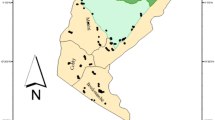Abstract
An investigation was conducted on distribution pattern, site condition and population structure of yew Taxus cuspidata Sieb. et Zucc. in Muling Forest Bureau of Heilongjiang Province, China in April, 2005. Results showed that yew is mainly distributed under the main storey of natural mixed forest of conifer and broadleaf, the soil moisture content of the yew site is high (40%–60%), the pH value of soil is relatively lower (4.7–5.5), and that the population structure of wild yew is not rational, belonging to the degeneration population, which is one of the reasons leading to the population decline. Although the site conditions of Muling area are suitable for the growth of wild yew, the population of wild yew shows a decline tendency, due to the fact that the middle-sized adult yew trees have been cut, young yews are often grazed by wildlife, and that the trunks of adult yew tend to be hollow.
Similar content being viewed by others
References
Bai Guangxin, Wu Banghua. 2002. Research in China’s Taxus. cuspidate [M]. Beijing: China Forestry Publishing House, p259. (in Chinese)
Begon, M., Mortimer, M. 1981. Population ecology: an unified study of animals and plants [M]. London: Blackwell Scientific Publication, p10–28.
Cai Fei. 2000. A study on the structure and dynamics of Cyclobalnopsis glauca population at hills around West Lake in Hangzhou [J]. Scientia Silvae Sinicae, 36(3): 67–72. (in Chinese)
Chen Yongqin, Zhu Weihua, Wu Yunqi. 2000. Effects of culture conditions on callus growth and taxol formation of Taxus yunnanensis Cheng et L. K. Fu [J]. China Journal of Chinese Materia Medica, 25(5): 269–272. (in Chinese)
Cui Chengwan, An Fengyun, Liu Xifa. 1996. Temperature influence on seed sprouting of Taxus cuspidate [J]. Chinese Traditional Medicine Magazine, 21: 20–22. (in Chinese)
Gao Shanlin, Tower G.H.N. 1994. Establishment and optimization of cell culture of Taxus Sp. [J]. Journal of China Pharmaceutical University, 25(6): 321–324. (in Chinese)
Gao Zhaowei, Wang Tingliang, Zou Gaoshun, et al. 2003. Study on distribution, habitat and cultivation technique of Taxus wallichiana var. mairei in Fujian Province [J]. East China Forest Management, 17: 6–13. (in Chinese)
Hao Rentaben, Zhao Ying. 2004. Tissue culture of Taxus cuspidata[J]. Inner Mongolia Forestry Science & Technology, 3: 11–13. (in Chinese)
Harper, J.L. 1977. Population biology of plants [M]. New York: Academic Press.
Li Bolin. 2001. Studies on taxol formation in taxus cell cultures [J]. Journal of Guangxi Normal University, 19(2): 84–87. (in Chinese)
Liu Feng, Chen Weilie, He Jinsheng. 2000. Population structure and regeneration of Quecus aliena var. ocuteserrata in Shennongjia [J]. Acta Phytoecol Sin, 24(4): 396–401. (in Chinese)
Mei Xingguo, Wu Qijun, Jiang Zhenran, et al. 2002. Regulation of taxol biosynthesis in cell suspension culture of Taxus cuspidata [J]. Life Science Research, 6: 152–155. (in Chinese)
Qiu Shuping, Liu Zhongling. 1994. Chinese rare and endangered plants [M]. Shanghai: Shanghai Science and Education Press, p55–57. (in Chinese)
Wang Senlin, Hu Fengqing. 2002. Study on callus culture of Taxus Cuspidata [J]. Journal of Liaoning University, 1: 75–77. (in Chinese)
Wang Bing, Zheng Hongyue. 1998. Identifying of yew (Taxus cuspidata) crude drug [J]. Journal of Traditional Chinese Medicine, 29: 267–269. (in Chinese)
Weng Zhiyuan, Wu Guangliu. 2003. Cultivation technique of Taxus wallichiana var. mairei in Taishun [J]. Journal of Zhejiang Forestry Science & Technology, 23: 3–41. (in Chinese)
Wu Banghua, Zhang Qichang, Li Dezhi. 1996. Study on growth and management of Taxus cuspidate [J]. Journal of Jilin Forestry University, 12: 125–129. (in Chinese)
Zhou Zhiqiang, Liu Tong, Yuan Jilian. 2004. Population characteristics of yew (Taxus cuspidata) in the Muling Yew Nature Reserve, Heilongjiang Province [J]. Acta Phytoecologica Sinica, 28(4): 476–482. (in Chinese)
Author information
Authors and Affiliations
Additional information
Foundation item: This study was supported by Department of Wildlife Conservation, State Forestry Administration, P. R. China.
Biography: ZU Yuan-gang (1954–), male, Professor in Key Laboratory of Forest Plant Ecology, Ministry of Education, Northeast Forestry University, Harbin 150040, P. R. China.
Rights and permissions
About this article
Cite this article
Zu, Yg., Chen, Hf., Wang, Wj. et al. Population structure and distribution pattern of Taxus cuspidata in Muling region of Heilongjiang Province, China. J. of For. Res. 17, 80–82 (2006). https://doi.org/10.1007/s11676-006-0019-z
Received:
Accepted:
Issue Date:
DOI: https://doi.org/10.1007/s11676-006-0019-z




